- Home
- Stephen Baxter
Space
Space Read online
Space
Manifold [2]
Stephen Baxter
Voyager (2000)
* * *
Rating: ★★★★☆
Tags: Science Fiction, General, Fiction
Science Fictionttt Generalttt Fictionttt
The year is 2020. Fueled by an insatiable curiosity, Reid Malenfant ventures to the far edge of the solar system, where he discovers a strange artifact left behind by an alien civilization: A gateway that functions as a kind of quantum transporter, allowing virtually instantaneous travel over the vast distances of interstellar space. What lies on the other side of the gateway? Malenfant decides to find out. Yet he will soon be faced with an impossible choice that will push him beyond terror, beyond sanity, beyond humanity itself. Meanwhile on Earth the Japanese scientist Nemoto fears her worst nightmares are coming true. Startling discoveries reveal that the Moon, Venus, even Mars once thrived with life?life that was snuffed out not just once but many times, in cycles of birth and destruction. And the next chilling cycle is set to begin again . . .
Review
"Baxter's work reminds us all what science fiction is truly about."
--GREG BEAR
Author of Darwin's Radio
From the Hardcover edition.
From the Inside Flap
The year is 2020. Fueled by an insatiable curiosity, Reid Malenfant ventures to the far edge of the solar system, where he discovers a strange artifact left behind by an alien civilization: A gateway that functions as a kind of quantum transporter, allowing virtually instantaneous travel over the vast distances of interstellar space. What lies on the other side of the gateway? Malenfant decides to find out. Yet he will soon be faced with an impossible choice that will push him beyond terror, beyond sanity, beyond humanity itself. Meanwhile on Earth the Japanese scientist Nemoto fears her worst nightmares are coming true. Startling discoveries reveal that the Moon, Venus, even Mars once thrived with life?life that was snuffed out not just once but many times, in cycles of birth and destruction. And the next chilling cycle is set to begin again . . .
STEPHEN BAXTER
SPACE
MANIFOLD 2
DEDICATION
To my nephew, Thomas Baxter and
Simon Bradshaw and Eric Brown
EPIGRAPH
Innumerable suns exist; innumerable earths
revolve around these suns in a manner similar to
the way the seven planets revolve around our
sun. Living beings inhabit these worlds …
GIORDANO BRUNO (1548–1600)
If they existed, they would be here.
ENRICO FERMI (1901–1954)
CONTENTS
Cover
Title Page
Dedication
Epigraph
Prologue
Part I: Foreigners
Chapter 1: Gaijin
Chapter 2: Baikonur
Chapter 3: Debates
Chapter 4: Ellis Island
Chapter 5: Saddle Point
Chapter 6: Transmission
Chapter 7: Reception
Part II: Travellers
Chapter 8: Ambassadors
Chapter 9: Fusion Summer
Chapter 10: Travels
Chapter 11: Anomalies
Chapter 12: Sister Planet
Chapter 13: The Roads of Empire
Chapter 14: Dreams of Ancestral Fish
Chapter 15: Colonists
Chapter 16: Icosahedral God
Chapter 17: Lessons
Part III: Trenchworks
Chapter 18: Moon Rain
Chapter 19: Dreams of Rock and Stillness
Chapter 20: The Tunnel in The Moon
Chapter 21: Homecoming
Chapter 22: Triton Dreamtime
Chapter 23: Cannonball
Part IV: Bad News From The Stars
Chapter 24: Kintu’s Children
Chapter 25: Wanpamba’s Tomb
Chapter 26: Kimera’s Breath
Chapter 27: The Face of Kintu
Chapter 28: People Came From Earth
Chapter 29: Bad News From The Stars
Chapter 30: Refuge
Chapter 31: End Game
Part V: The Children’s Crusade
Chapter 32: Savannah
Chapter 33: The Fermi Paradox
Chapter 34: The Children’s Crusade
Epilogue
Afterword
Acknowledgements
By the Same Author
Copyright
About the Publisher
PROLOGUE
My name is Reid Malenfant.
You know me. And you know I’m an incorrigible space cadet.
You know I’ve campaigned for, among other things, private mining expeditions to the asteroids. In fact, in the past I’ve tried to get you to pay for such things. I’ve bored you with that often enough already, right?
So tonight I want to be a little more personal. Tonight I want to talk about why I gave over my life to a single, consuming project.
It started with a simple question:
Where is everybody?
As a kid I used to lie at night out on the lawn, soaking up dew and looking at the stars, trying to feel the Earth turning under me. It felt wonderful to be alive – hell, to be ten years old, anyhow.
But I knew that the Earth was just a ball of rock, on the fringe of a nondescript galaxy.
As I lay there staring at the stars – the thousands I could pick out with my naked eyes, the billions that make up the great wash of our Galaxy, the uncounted trillions in the galaxies beyond – I just couldn’t believe, even then, that there was nobody out there looking back at me down here. Was it really possible that this was the only place where life had taken hold – that only here were there minds and eyes capable of looking out and wondering?
But if not, where are they? Why isn’t there evidence of extraterrestrial civilization all around us?
Consider this. Life on Earth got started just about as soon as it could – as soon as the rocks cooled and the oceans gathered. Of course it took a good long time to evolve us. Nevertheless we have to believe that what applies on Earth ought to apply on all the other worlds out there, like or unlike Earth; life ought to be popping up everywhere. And, as there are hundreds of billions of stars out there in the Galaxy, there are presumably hundreds of billions of opportunities for life to come swarming up out of the ponds – and even more in the other galaxies that crowd our universe.
Furthermore, life spread over Earth as fast and as far as it could. And already we’re starting to spread to other worlds. Again, this can’t be a unique trait of Earth life.
So, if life sprouts everywhere, and spreads as fast and as far as it can, how come nobody has come spreading all over us?
Of course the universe is a big place. There are huge spaces between the stars. But it’s not that big. Even crawling along with dinky ships that only reach a fraction of lightspeed – ships we could easily start building now – we could colonize the Galaxy in a few tens of millions of years. One hundred million, tops.
One hundred million years: it seems an immense time – after all, a hundred million years ago the dinosaurs ruled Earth. But the Galaxy is a hundred times older still. There has been time for Galactic colonization to have happened many times since the birth of the stars.
Remember, all it takes is for one race somewhere to have evolved the will and the means to colonize; and once the process has started it’s hard to see what could stop it.
But, as a kid on that lawn, I didn’t see them. I seemed to be surrounded by emptiness and silence.
Even we blare out on radio frequencies. Why, with our giant radio telescopes we could detect a civilization no more advanced than ours anywhere in the Gal
axy. But we don’t.
More advanced civilizations ought to be much more noticeable. We could spot somebody building a shell around their star, or throwing in nuclear waste. We could probably see evidence of such things even in other galaxies. But we don’t. Those other galaxies, other reefs of stars, seem to be as barren as this one.
Maybe we’re just unlucky. Maybe we’re living at the wrong time. The Galaxy is an old place; maybe They have been, flourished, and gone already. But consider this: even if They are long gone, surely we should see Their mighty ruins, all around us. But we don’t even see that. The stars show no signs of engineering. The solar system appears to be primordial, in the sense that it shows no signs of the great projects we can already envisage, like terraforming the planets, or tinkering with the sun, and so on.
We can think of lots of rationalizations for this absence.
Maybe there is something that kills off every civilization like ours before we get too far – for example, maybe we all destroy ourselves in nuclear wars or eco collapse. Or maybe there is something more sinister, plagues of killer robots sliding silently between the stars, which for their own antique purposes kill off fledgling cultures.
Or maybe the answer is more benevolent. Maybe we’re in some kind of quarantine – or a zoo.
But none of these filtering mechanisms convinces me. You see, you have to believe that this magic suppression mechanism, whatever it is, works for every race in this huge Galaxy of ours. All it would take would be for one race to survive the wars, or evade the vacuum robots, or come sneaking through the quarantine to sell trinkets to the natives – or even just to start broadcasting some Eetie version of The Simpsons, anywhere in the Galaxy – and we’d surely see or hear them.
But we don’t.
This paradox was first stated clearly by a twentieth-century physicist called Enrico Fermi. It strikes me as a genuine mystery. The contradictions are basic: life seems capable of emerging everywhere; just one starfaring race could easily have covered the Galaxy by now; the whole thing seems inevitable – but it hasn’t happened.
Thinking about paradoxes is the way human understanding advances. I think the Fermi paradox is telling us something very profound about the universe, and our place in it. Or was.
Of course, everything is different now.
I
FOREIGNERS
AD 2020–2042
… And he felt as if he was drowning, struggling up from some thick, viscous fluid, up towards the light. He wanted to open his mouth, to scream – but he had no mouth – and no words. What would he scream?
I.
I am.
I am Reid Malenfant.
He could see the sail.
It was a gauzy sheet draped across the crowded stars of this place – where, Malenfant? why, the core of the Galaxy, he thought, wonder breaking through his agony – and within the sail, cupped, he could see the neutron star, an angry ball of red laced with eerie synchrotron blue, like a huge toy.
A star with a sail attached to it. Beautiful. Scary.
Triumph surged. I won, he thought. I resolved the koan, the great conundrum of the cosmos; Nemoto would be pleased. And now, together, we’re fixing an unsatisfactory universe. Hell of a thing.
… But if you see all this, Malenfant, then what are you?
He looked down at himself.
Tried to.
A sense of body, briefly. Spread-eagled against the sail’s gauzy netting. Clinging by fingers and toes, monkey digits, here at the centre of the Galaxy. A metaphor, of course, an illusion to comfort his poor human mind.
Welcome to reality.
The pain! Oh, God, the pain.
Terror flooded over him. And anger.
And, through it, he remembered the Moon, where it began …
Chapter 1
GAIJIN
A passenger in the HOPE-3 tug, Reid Malenfant descended towards the Moon.
The Farside base, called Edo, was a cluster of concrete components – habitation modules, power plants, stores, manufacturing facilities – half-buried in the cratered plain. Comms masts sprouted like angular flowers. The tug pad was just a splash of scorched Moon-dust concrete, a couple of kilometres further out. Around the station itself, the regolith was scarred by tractor traffic.
Robots were everywhere, rolling, digging, lifting; Edo was growing like a colony of bacilli in nutrient.
A hi-no-maru, a Japanese sun flag, was fixed to a pole at the centre of Edo.
‘You are welcome to my home,’ Nemoto said.
She met him in the pad’s airlock, a large, roomy chamber blown into the regolith. Her face was broad, pale, her eyes black; her hair was elaborately shaved, showing the shape of her skull. She smiled, apparently habitually. She could have been no more than half Malenfant’s age, perhaps thirty.
Nemoto helped Malenfant don the suit he’d been fitted with during the flight from Earth. The suit was a brilliant orange. It clung to him comfortably, the joints easy and loose, although the sewn-in plates of tungsten armour were heavy.
‘It’s a hell of a development from the old EMUs I wore when I was flying Shuttle,’ he said, trying to make conversation.
Nemoto listened politely, after the manner of young people, to his fragments of reminiscence from a vanished age. She told him the suit had been manufactured on the Moon, and was made largely of spider silk. ‘I will take you to the factory. A chamber in the lunar soil, full of immense spinnerets. A nightmare vision! …’
Malenfant felt disoriented, restless.
He was here to deliver a lecture, on colonizing the Galaxy, to senior executives of Nishizaki Heavy Industries. But here he was being met off the tug by Nemoto, the junior researcher who’d invited him out to the Moon, just a kid. He hoped he wasn’t making some kind of fool of himself.
Reid Malenfant used to be an astronaut. He’d flown the last Shuttle mission – STS-194, on Discovery – when, ten years ago, the space transportation system had reached the end of its design life, and the International Space Station had finally been abandoned, incomplete. No American had flown into space since – save as the guest of the Japanese, or the Europeans, or the Chinese.
In this year 2020, Malenfant was sixty years old and feeling a lot older – increasingly stranded, a refugee in this strange new century, his dignity woefully fragile.
Well, he thought, whatever the dubious politics, whatever the threat to his dignity, he was here. It had been the dream of his long life to walk on another world. Even if it was as the guest of a Japanese.
And even if he was too damn old to enjoy it.
They stepped through a transit tunnel and directly into a small tractor, a lozenge of tinted glass. The tractor rolled away from the tug pad. The wheels were large and open, and absorbed the unevenness of the mare; Malenfant felt as if he were riding across the Moon in a soap bubble.
Every surface in the cabin was coated with fine, grey Moon dust. He could smell the dust; the scent was, as he knew it would be, like wood ash, or gunpowder.
Beyond the window, the Mare Ingenii – the Sea of Longing – stretched to the curved horizon, pebble-strewn. It was late in the lunar afternoon, and the sunlight was low, flat, the shadows of the surface rubble long and sharp. The lighting was a rich tan when he looked away from the sun, a more subtle grey elsewhere. Earth was hidden beneath the horizon, of course, but Malenfant could see a comsat crawl across the black sky.
He longed to step through the glass, to touch that ancient soil.
Nemoto locked in the autopilot and went to a little galley area. She emerged with green tea, rice crackers and dried ika cuttlefish. Malenfant wasn’t hungry, but he accepted the food. Such items as the fish were genuine luxuries here, he knew; Nemoto was trying to honour him.
The motion of the tea, as she poured it in the one-sixth gravity, was complex, interesting.
‘I am honoured you have accepted my invitation to travel here, to Edo,’ Nemoto said. ‘You will of course tour the town, as you wish.
There is even a Makudonarudo here. A McDonald’s. You may enjoy a bifubaaga! … soya, of course.’
He put down his plate and tried to meet her direct gaze. ‘Tell me why I’ve been brought out here. I don’t see how my work, on long-term space utilization, can be of real interest to your employers.’
She eyed him. ‘You do have a lecture to deliver, I am afraid. But – no, your work is not of primary concern to Nishizaki.’
‘Then I don’t understand.’
‘It is I who invited you, I who arranged the funding. You ask why. I wished to meet you. I am a researcher, like you.’
‘Hardly a researcher,’ he said. ‘I call myself a consultant, nowadays. I am not attached to a university.’
‘Nor I. Nishizaki Heavy Industries pay my wages; my research must be focused on serving corporate objectives.’ She eyed him, and took some more fish. ‘I am salariman. A good company worker, yes? But I am, at heart, a scientist. And I have made some observations which I am unable to reconcile with the accepted paradigm. I searched for recent scientific publications concerning the subject area of my – hypothesis. I found only yours.
‘My subject is infrared astronomy. At our research station, away from Edo, the company maintains radiometers, photometers, photopolarimeters, cameras. I work at a range of wavelengths, from twenty to a hundred microns. Of course a space-borne platform is to be preferred: the activities of humankind are thickening the Moon’s atmosphere with each passing day, blocking the invisible light I collect. But the lunar site is cheap to maintain, and is adequate for the company’s purposes. We are considering the future exploitation of the asteroids, you see. Infrared astronomy is a powerful tool in the study of those distant rocks. With it we can deduce a great deal about surface textures, compositions, internal heat, rotation characteristics –’
‘Tell me about your paradigm-busting hypothesis.’
‘Yes.’ She sipped her green tea. She said calmly, ‘I believe I have observational evidence of the activity of extraterrestrial intelligences in the solar system.’

 The Martian in the Wood
The Martian in the Wood THE H-BOMB GIRL
THE H-BOMB GIRL World Engine
World Engine Titan n-2
Titan n-2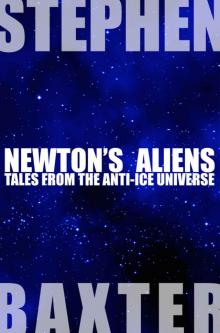 Newton's Aliens: Tales From the Anti-Ice Universe
Newton's Aliens: Tales From the Anti-Ice Universe Exultant
Exultant Manifold: Origin
Manifold: Origin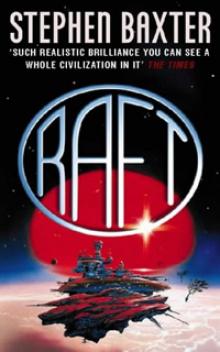 Raft xs-1
Raft xs-1 Bronze Summer n-2
Bronze Summer n-2 Transcendent
Transcendent Stone Spring
Stone Spring Coalescent
Coalescent The Medusa Chronicles
The Medusa Chronicles Origin m-3
Origin m-3 Silverhair tm-1
Silverhair tm-1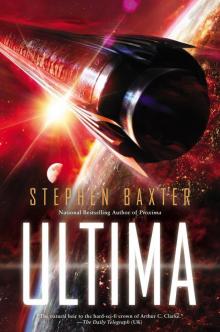 Ultima
Ultima Voyage n-1
Voyage n-1 Xeelee: Endurance
Xeelee: Endurance Space m-2
Space m-2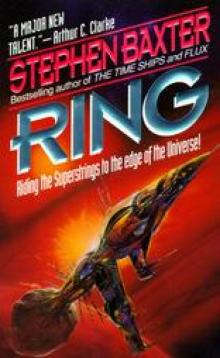 Ring xs-4
Ring xs-4 Raft
Raft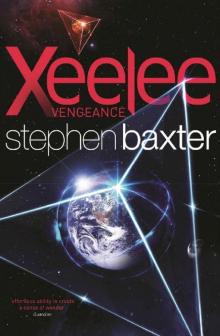 Xeelee: Vengeance
Xeelee: Vengeance Iron Winter n-3
Iron Winter n-3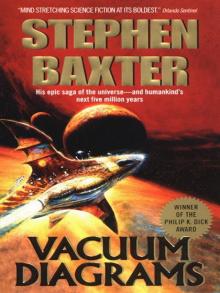 Vacuum Diagrams
Vacuum Diagrams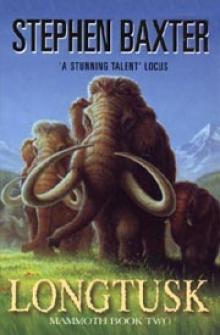 Longtusk tm-2
Longtusk tm-2 Proxima
Proxima Evolution
Evolution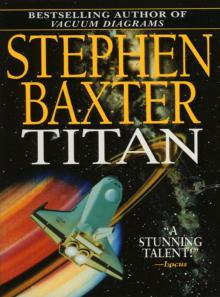 Titan
Titan Last and First Contacts (Imaginings)
Last and First Contacts (Imaginings) Emperor
Emperor The Massacre of Mankind
The Massacre of Mankind Starfall
Starfall Doctor Who - The Wheel of Ice
Doctor Who - The Wheel of Ice Longtusk
Longtusk Silverhair
Silverhair Conqueror tt-2
Conqueror tt-2 Flood
Flood Flood f-1
Flood f-1 Emperor tt-1
Emperor tt-1 Moonseed
Moonseed Conqueror
Conqueror Timelike Infinity xs-2
Timelike Infinity xs-2 The Ghost Pit
The Ghost Pit Xeelee: An Omnibus: Raft, Timelike Infinity, Flux, Ring
Xeelee: An Omnibus: Raft, Timelike Infinity, Flux, Ring Weaver tt-4
Weaver tt-4 Landfall: Tales From the Flood/Ark Universe
Landfall: Tales From the Flood/Ark Universe Ark
Ark Emperor: Time’s Tapestry Book One
Emperor: Time’s Tapestry Book One Space
Space Icebones
Icebones Manifold: Space
Manifold: Space Navigator
Navigator Obelisk
Obelisk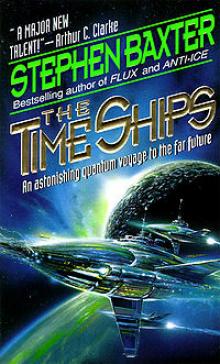 The Time Ships
The Time Ships Bronze Summer
Bronze Summer Resplendent
Resplendent Moonseed n-3
Moonseed n-3 Flux xs-3
Flux xs-3 Transcendent dc-3
Transcendent dc-3 Icebones tm-3
Icebones tm-3 Phase Space
Phase Space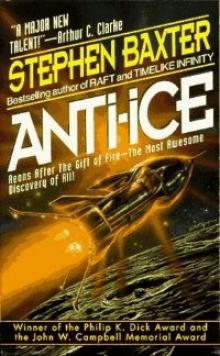 Anti-Ice
Anti-Ice Weaver
Weaver Voyage
Voyage Time m-1
Time m-1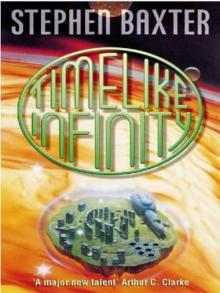 Timelike Infinity
Timelike Infinity Exultant dc-2
Exultant dc-2 Coalescent dc-1
Coalescent dc-1 Navigator tt-3
Navigator tt-3